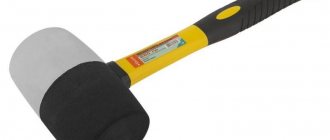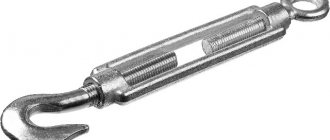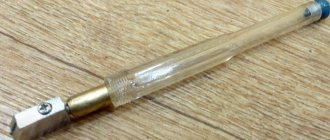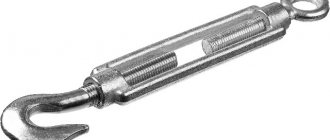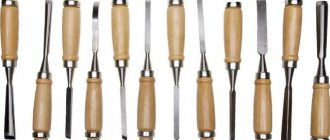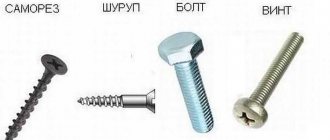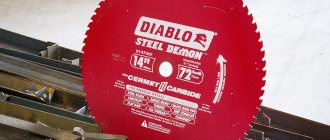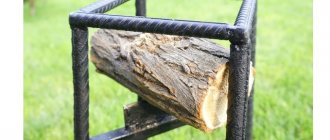Main characteristics
The cleaver is not an ax in the full sense, but it is directly related to it.
A hand tool has an ax handle on which a wedge-shaped working part (head) is mounted without sharp sharpening.
The cleaver is designed for a single blow, after which the log will split into pieces.
What is important here is not the sharpening of the blade, but the force of the blow.
Externally, the cleaver resembles more a sledgehammer than a classic axe.
One side of the head is flat (butt), and the opposite is wedge-shaped, made in the form of a double-sided cut at an angle of 40 - 50 degrees.
The weight of the cleaver reaches 5 kg, which allows it to cope even with large logs.
The meaning of this design lies not in cutting through the wood fibers, but in their delamination.
The thickness and length of the ax depends, first of all, on the size of the cleaver's head.
At the same time, the size of the handle directly affects the efficiency of work, since a long ax paired with a heavy head concentrates a decent impact force on a small area.
Blade
As already mentioned, the blade of the cleaver does not have a sharp edge.
Depending on the shape, wedge-shaped (wedge-shaped) and eared options are distinguished.
The second type, as the summer residents themselves note, is much inferior to the wedge-shaped ax in terms of ease of use.
It is noted that the head, due to the presence of “ears” set apart, often gets stuck in logs, after which it is difficult to remove.
The manufacturers themselves respond to this claim by saying that this design is designed to work with dry wood.
In reality, the owners of a private house use a tool to split raw, recently cut trunks, which is incorrect.
The piercing edge can be straight or rounded.
The first version of the cleaver is suitable for working with large dry logs.
The rounded blade has a larger size, which allows it to cope with resinous and damp wood.
The cleaver's head is made using the following methods:
• Stamping
Medium carbon steel is used.
In most cases, stamped cleavers weigh more than 2.5 kg, and their center of gravity is concentrated in the head. This allows you to use such a tool for working with large logs.
• Casting
The blade is made of hardened steel and is usually smaller in size compared to the option mentioned above.
They come in both straight and rounded.
Cast axes are more reminiscent of an axe.
Handle
The wooden ax handle is a classic.
It has always been used and will remain relevant for decades to come.
Unlike metal, wood has the beneficial property of absorbing shock and vibration.
In addition, wooden handles are relatively cheap and easy to manufacture.
All this affects the cost of the instrument for the better.
However, among the disadvantages it is worth noting the fact that the ax handle, if the technique of working with the cleaver is incorrect, splits.
An alternative to wood is fiberglass, a composite material with good strength properties.
Some models are produced with a rubberized handle, thereby increasing ease of use.
At the same time, it is lightweight, which allows you to shift the center of gravity of the instrument towards the head.
Fiberglass handle is a suitable solution for heavy cleavers.
How to choose a classic firewood cleaver?
Many novice splitters are wondering: which splitting splitter is best for firewood ? Let's just say that there is nothing difficult in choosing this tool. You just need to take into account a few characteristics - weight, length and material of the handle, shape of the blade. a classic firewood cleaver should be .
Cleaver weight
The average weight of a cleaver should be 2-2.5 kg - this is ideal. Then it has enough strength to split wood, but also moderate weight so that you can handle it. However, when buying a cleaver , it is best for you to hold the tool in your hands. You must understand that it is not too heavy for you. Chopping wood is a long process that requires a lot of strength, so it is important that you are comfortable working with the tool.
Handle length and material
The handle can be wooden or fiber plastic. With the length of the handle, everything is quite simple - the force of the blow depends on it. Again, you should not overdo it and choose the cleaver with the longest ax possible. After all, you need to work with him, and it should not only bear fruit, but also be as pleasant as possible for you. To choose the correct length of the handle, place the cleaver on the ground vertically next to your foot, the handle should be such a length that your hand lowered down freely covers the edge of the handle.
Blade shape
The shape of the blade is one of the most important indicators that will help you chop firewood faster and better. There are two types of blades - “eared”, which is easiest to chop dry wood, and a dull wedge-shaped blade, designed for wet firewood. The second type, unlike the first, due to its shape cannot stick into a log. That is why it is better to use it for raw wood. Please note that the cleaver blade should not be sharp! You can answer
the question of how to choose a cleaver for firewood First of all, you should be comfortable working with him - this is the main thing you should pay attention to. Only then will your work be effective.
Description
Many people mistakenly believe that an ax is the same as a cleaver. In fact, these are different things. More precisely, a firewood cleaver is a type of axe. Its main difference is that trees are cut down with an ax, and firewood is chopped with a cleaver . Thanks to it, even a huge tree trunk turns into small logs, which are very convenient to use.
In addition to functionality, it differs from an ax in appearance. The ax has a thin, very sharp blade with slight curves. The cleaver is a rather voluminous structure, the weight of which can be three kilograms, and the ax handle is quite long.
When talking about a cleaver or an axe, there is no need to explain the method of their use, since it is clear to everyone. When cutting down a tree, you need to repeatedly hit the trunk with an ax, while holding the tool at arm's length. Working with a cleaver is a little different: the log should split into pieces with one blow. It is not difficult to understand that the sharpness of its blade is important for an ax, and the striking force for a cleaver .
Structure and types of tools
There is nothing to say about the design of this tool - it consists of an ax and a “head”. Everything is very simple and clear.
As a rule, the ax handle is made of flexible and soft wood, which includes:
- birch;
- maple;
- elm;
- ash.
Some craftsmen make axes from oak, but such an ax or cleaver can only be used by an experienced woodcutter. Oak is a fairly hard wood and this is a significant disadvantage for an instrument. The handle will break very quickly due to the fact that there will be no vibration damping upon impact, and it will simply crack. This, unfortunately, happens quite often.
Externally, the tool is very similar to a sledgehammer with a sharpened side (blade), the other side is called the butt. The weight of such a “head” can be from three to five kilograms. The blade must be sharpened at an angle of 45 degrees, this is what causes the log to split into pieces.
The ax has many varieties:
- universal;
- blacksmith;
- for the lumberjack;
- carpentry;
- butcher;
- firefighter.
Cleavers are divided into only two types:
- heavy;
- pointed.
The first type is very similar to a sledgehammer, and the second is the same in weight, but the blade is sharper.
There is another classification of cleavers, according to which the tool can be:
- forged;
- cast.
There is no significant difference when using the tool; these factors do not have much influence on the quality of the result. The structure of the cleaver is much more important.
Options
There are no universal recommendations for choosing a cleaver for chopping wood. You should choose a tool based on some individual factors:
- weight;
- ax material;
- length of the ax;
- blade shape.
The weight of the tool is the most ambiguous characteristic. On the one hand, a heavier cleaver will be easier to chop wood; when working with a lighter one, you will need to hit the wood several times.
It should be borne in mind that collecting firewood is not an easy and long process. Not every man can swing a cleaver for several hours in a row. That is why a tool for chopping wood must correspond to the physical capabilities of the particular person who will work with it.
Unfortunately, you may not find your ideal tool right away. If you are buying a tool for yourself, then you should not take the first one you come across. You need to hold the model in your hands, swing it and feel its work.
For a person with average physical fitness, the optimal weight of the instrument will be 2-2.5 kilograms. For larger and stronger people, a heavier cleaver is quite suitable. It is very convenient to work with a light tool; it splits small logs without any problems, but it may not be able to cope with larger logs.
Blade shape
A suitable cleaver can be selected according to the shape of the blade. They come in two versions:
- wedge-shaped;
- "eared".
The eared species appeared on the market relatively recently and reviews about it are contradictory. Experienced woodcutters say that it often does not split logs and gets stuck very firmly in them.
This suggests the conclusion that the wedge-shaped species has no competition, but in fact this is not the case. The instructions for the “eared” blade contain a disclaimer stating that only dry firewood can be split with this tool . It's no secret that very often people chop raw or freshly cut firewood, for which the wedge-shaped type is best suited. The main thing is to use the tool correctly and then everything will definitely work out!
Toporische
Until recently, cleavers only had wooden handles. The handles of axes and cleavers have always been made of wood to dampen the vibrations of the blows. It is impossible not to say about the cost of such axes, since their low cost is a fundamental factor in purchases for many people.
There is only one drawback to such handles, and that is that they can crack if used improperly. The point is not in the strength of the handle, and not in its quality, but in the striking technique.
More recently, handles made from a composite material called fiberglass began to be produced. Despite the fact that it is very light, fiberglass is superior to wood in many ways, especially in its strength. Vibration damping from impact in this material is also at the proper level. This handle makes the tool very comfortable , dense and durable. A handle made of composite material can be of any length, and therefore this option is preferable to a model with a wooden ax.
The length of the handle directly affects the force of the blow - the longer the lever, the greater the force. To fully unlock the potential of such a cleaver, you need to use it correctly. In other words, using a long handle will only be effective in the hands of an experienced person. Beginner users will find it difficult to work with such a tool.
Types of cleavers and their characteristics
There are several classifications of wood splitters.
According to the method of applying the splitting force:
- dynamic, a short blow is delivered by a massive blade accelerated to a certain speed;
- static, the force gradually increases until the moment of splitting.
According to the method of laying chocks, they are divided into:
- vertical, the blade is located horizontally, it is pressed into the block from above or below;
- horizontal, the blade is positioned vertically, the block lying on the base is pushed onto it (or vice versa);
- universal, the bookmark method may vary depending on the selected current device configuration.
Universal units are usually powerful and expensive and are used in industrial environments.
According to the method of delivery, they are distinguished:
- with movable blade;
- with log pusher.
What does a wood splitting cleaver look like
? There is no fundamental difference between them; the choice depends on the ease of implementation. Blades of complex configuration, capable of splitting a log into several parts, are often made motionless
According to the drive method, wood splitters are divided into manual and mechanical.
Manual
Powered by human muscle power. These also include traditional wood splitting axes - heavy wedge-shaped axes with a long handle. They require a lot of energy and certain work skills, especially when splitting damp, twisted and knotty logs. Recently, cleavers with a blade of complex curved shape have appeared, making splitting easier. With such an ax, even a woman or teenager can master a knotted log.
Mechanical
In them, human muscular force is applied to the blade through a system of levers, springs, and hinges. The mechanism converts the applied forces and increases them due to the greater distance traveled by the handle.
The same type includes splitting axes with a blade fixed vertically to the base and a ring - a clip. A log is placed in it, and it is hit from above with an ordinary sledgehammer. The blade splits the log into two or four parts. Such devices are safer than hand axes.
Mechanical with electric drive
Here the drive is carried out by an electric motor and its torque is converted by a gearbox. Rack and worm gears are used. Most often, a horizontal bookmark is used. Such installations do not require physical effort when splitting. With them, without getting tired, even a teenager or a woman can chop a week’s worth of a healthy woodcutter with a huge cleaver in half a day. Performance depends on the power of the electric motor and the type of transmission.
Screw
It is somewhat different from all other devices in the way it applies force and the type of blade. They look not like a wedge, but like a cone of rotation. The blade rests its tip against the log not from the cut side, but from the gathering side, and is screwed between the fibers, pushing them apart until the layers break. The drive can be manual or electric. Capable of splitting the most knotty and damp logs.
Screw cleaver
Hydraulic
The pressure on the blade or on the pusher is carried out by a hydraulic cylinder. This type of device is the most productive, but also the most difficult to design and maintain.
Why is it worth making a cleaver?
A cleaver is the simplest device for chopping wood. Of course, you can purchase such an ax in a specialized store or order it on a thematic Internet site. However, the cost of such industrial devices sometimes reaches twenty thousand rubles. It makes sense to buy such things only if a lot of firewood is used to heat the room. If we are talking about a small house in which a family of three or four people lives, buying such a “gadget” is unprofitable. It’s much easier to make a cleaver with your own hands, and here’s why:
- Working with a mechanical cleaver is easier and safer than with an electric one.
- If a master makes a cleaver with his own hands, he adapts it “to suit himself”, independently choosing the weight, length of the handle, width and sharpness of the blade;
- The cost of making a splitting cleaver at home is much less than the cost of purchasing and delivering modern electrical equipment for splitting firewood;
- If the ax is comfortable and not heavy, a woman can easily handle it. But representatives of the fair sex may not understand electrical equipment.
The simplest hand-made cleaver looks about the same as an ordinary ax, but with a small feature.
Advantages and disadvantages
The main advantages of any wood splitter are
- facilitating the work of splitting;
- high performance;
- reducing the requirements for physical strength, endurance and qualifications of the employee;
- increasing work safety.
Among the disadvantages of wood splitters are:
- design complexity, especially for hydraulic models;
- need for maintenance;
- operating costs for electricity or fuel;
- high cost of productive models.
It makes sense to buy such a unit only when there is a large amount of work to be done, for example, chopping firewood to heat a large house during a long winter. If you need to chop up a small woodpile to light the fireplace on weekends, a complex and expensive device will not pay for itself.
Simple models of wood splitters can be made with your own hands in a home workshop.
Mechanical splitting axes
Naturally, these devices are easier to work with. You can be offered two types of mechanical cleavers. The first is screw, the most common. Its main part is a steel cone with large threads.
Read here: How to choose good pliers: a review of the best types of professional tools
Thanks to the rotating element, this thread seems to dig and go deep into the wood and easily splits it, even if the firewood is quite large.
The second option is hydraulic. It has more performance than the first one, but it is very difficult to make yourself. This cleaver instantly breaks the wood into the required sizes. It can run on electricity or gasoline, depending on the manufacturer, but it will cost more.
Main types of cleavers
Hand cleavers can be divided into types depending on the size and shape of the head.
Modern instruments, due to their design features, can have several types of features at the same time:
Big cleaver
Large massive head and long handle.
Weight can reach 5kg.
Mini cleaver
It weighs from 1.5 kg and has a relatively short handle, up to 60 cm, which limits the scope of use of this tool.
Not suitable for working with large logs, and for thin branches it is preferable to use an ordinary ax.
“Iron”
A classic of domestic production.
A large tool with a hole for the handle located close to the butt.
Sledgehammer
A heavy tool designed for working with large logs.
The presence of a striking butt allows the tool to be used for driving in wedges.
Wedge-shaped
It has straight bevels and looks like a wedge.
Eared
Thin blade, like an ordinary axe.
At the same time, there are special “ears” on the head, designed to sharply expand the crack during an impact.
Chinese
The Chinese cleaver deserves special mention.
It is distinguished by a narrow nose, which, in fact, is a wedge with a handle.
It gets stuck into wood the first time, but often gets stuck tightly.
You can remove the head by hitting the butt on a log or by rocking.
As a result, you can observe a burst eye or a violation of the attachment of the ax to the cleaver.
How to sharpen a cleaver correctly
The question of sharpening the blade of a cleaver ax remains open today.
Is it worth sharpening it at all?
The thickness of the blade, as a rule, does not exceed 5 mm over the entire surface, and experts advise using a floating sharpening (sharpness increases towards the center of the tool blade).
This will allow you to cope with wood of various species.
The sharpening angle also matters.
For most cleavers, the wedge is sharpened at an angle of 40 - 60 degrees.
At the same time, an angle that is too sharp is not suitable for working with soft and wet material.
The tool will get stuck in the fibers.
An obtuse angle is not suitable for frozen and dry logs, as the tool will simply bounce off.
The blade is sharpened with an electric sharpener at low speed.
Periodically, you need to moisten the wedge of the tool with water, which will prevent it from overheating during friction.
Rating of the best cleavers for chopping wood
| Nomination | place | Name of product | price |
| Rating of the best cleavers for chopping wood | 1 | FISKARS X25 | 6 000 ₽ |
| 2 | GARDENA 1600S (8718-48) | 3 500 ₽ | |
| 3 | Kraftool X25 | 3 200 ₽ | |
| 4 | PATRIOT PA 711 | 2 700 ₽ | |
| 5 | MATRIX 21822 | 1 700 ₽ | |
| 6 | Gross 21500 | 2 500 ₽ | |
| 7 | VORTEX K2700F | 1 600 ₽ | |
| 8 | BISON 20616-10 | 1 000 ₽ |
FISKARS X25
Rating: 4.9
The Finnish FISKARS X25 splitting splitter will help you experience real pleasure from chopping wood. The manufacturer has thought through the design so well that chopping logs takes a minimum of time and physical effort. The ax will be the best option for chopping firewood up to 30 cm thick. Experts note a 25-year warranty period, which indicates the reliability and durability of the tool. The tool should include an anti-friction coating, a rubber-coated fiberglass handle, and a plastic case. The cleaver is the winner of our review.
How to properly sharpen a carpenter's ax
There are two types of methods for sharpening an ax - manual and mechanized. Each of them, with a competent approach, is able to bring the instrument to perfection.
Bulgarian
The sparks emitted by the grinder are dangerous if the ax is sharpened by a person who is not protected by special clothing and glasses. This method, although fast, is not effective, since heating the metal worsens the performance characteristics of the ax.
On sandpaper
You can sharpen an ax on emery only after making sure that the grinding wheel is free of defects. Next, mark the corner to be cut with a marker. After this, fix the tool and turn the grinding wheel. Sharpening is completed when the surface marked with a marker on the blade is completely erased.
Varieties of cleavers
The classification of axes is surprisingly diverse: carpenter's axes, universal carpenter's axes, lumberjack's axe, cleaver, blacksmith's axe, butcher's axe, fire axe.
However, cleavers for firewood can also differ from each other. They are divided into two types:
- A heavy cleaver, reminiscent in appearance of a sledgehammer.
- No less heavy, but more pointed cleaver.
Cast cleaver 4000g
There is another way of classification:
- Forged cleaver.
- Cast cleaver.
In principle, there is no significant difference when using them, and this factor does not have a special impact on the quality of the work performed. It is much more important what structure the cleaver has in general terms.
Forged cleaver 3 kg
How is it different from an axe?
A cleaver is a type of axe. This tool is intended primarily for splitting large ingots. The blade of a cleaver also differs from the blade of an axe: it is wedge-shaped and weighs at least 3.5 kg. A cleaver does not cut like an axe, it splits the material. The fundamental difference lies precisely in this. When working with a cleaver, the power of the blow is important, and when working with an ax, it is important how sharp the tool is sharpened.
The cleaver can be compared to a sledgehammer; its blade is sharpened at an angle of 45 degrees, which allows it to split even massive logs with many knots.
There are cleavers:
- forged;
- all-metal (cast).
For a middle-aged man with standard physical capabilities, a cleaver with a blade weight of up to 3 kg is suitable.
How to properly store a cleaver
Storing a cleaver is no different from storing an ordinary axe.
Branded models are paired with plastic or leather cases, which allows you not only to store, but also to safely transport the instrument in a car or even public transport.
The metal part is coated with lubricant to prevent rust formation.
A tool with a large head can be safely coated with a thin layer of automotive oil.
For branded expensive models, a special lubricant for the ax is sold.
Tools with a wooden ax should not be stored in direct sunlight.
It is also not recommended to work in temperatures below -20.
It is best to store axes in rooms with average humidity.
How to choose?
The choice of tool is dictated by the following criteria:
- weight;
- material;
- dimensions of the ax;
- sharpening shape.
Selecting a tool that matches the physical characteristics of the worker is not the easiest task. If the cleaver is too light, it will be difficult to split massive fragments, and when working with a heavy tool, more physical effort will be spent, but at the same time it will be much easier to split heavy ingots.
It is also important that the ax handle is made of durable wood, which has “astringent” properties. The handle experiences significant load, so it must have the above qualities. A short handle is also not suitable - it is difficult to work with. Handles that are made of PVC or steel are not the best choice. Such axes are expensive, but working with such a tool is inconvenient. Such a tool will not be able to trim trunks soaked in moisture, the diameter of which is more than 25 cm. The ax handle gets stuck in such material quite often.
Thrifty owners, as a rule, use one of two types of axes: classic or wedge-shaped. The first type is convenient for handling freshly cut wood, which contains a lot of moisture. The second type is convenient for splitting dry trimmings of logs.
Cone axes are easy to use and quite effective (especially when working with massive pieces of wood). The pig is installed perpendicularly, a screw is driven into it, then it splits. The work is simply mechanical.
The hydraulic drive helps in solving production problems - it makes it possible to separate logs immediately.
It makes sense to use such a device if you constantly work with massive wood pieces, because a hydraulic splitter is quite expensive.
Choosing a cleaver
- First of all, you need to take into account the weight of the tool, since it must correspond to the physical development of the person who will use it.
- Before purchasing a tool, you need to consider what type of firewood will be split: dry or wet. In accordance with this, you need to buy either the “eared” or wedge-shaped type.
- The length of the ax and the material from which it is made are very important. Here user experience is a fundamental factor. You should also consider your financial capabilities. The wooden handle is not very practical, but its cost is very affordable. A handle made of composite material is much more practical, but much more expensive.
Safety precautions when chopping wood
When chopping wood with a hand cleaver, the following requirements must be observed:
- the log is placed on the edge of the deck farthest from the person; if you miss, the ax will stick into the deck, and not into the leg;
- the legs should be spread wide apart so that a broken cleaver does not hit the leg;
- split logs should be immediately taken away or thrown away from under your feet;
- there should be no other people on the swing line;
- Protective gloves, sturdy shoes and goggles are required.
When working with mechanized axes, the following rules are added:
- do not stand on the line of division;
- Place the chock and pick up the chopped logs only when the feed is turned off.
Before turning on the device, be sure to inspect it and check its serviceability.
Chopping wood - with a properly selected manual or mechanized splitter, turns from a tedious task into easy entertainment. With certain working and design skills, simple models of cleavers can be assembled in a home workshop. Compliance with safety regulations will help preserve health and life.
Rules for working as a cleaver
An experienced person will get the job done faster due to the fact that he knows the nuances. Experts give some advice to beginners. While you gain experience, they will make your work easier:
- Before you start, you need to find a stand. The largest log in diameter will serve it, but the cut should be straight. The deck is placed on a hard surface so that the blow is not absorbed.
- In the summer the logs must be allowed to dry, but in the winter they will freeze. In both cases, it will be easier to split such logs. Fresh wood is tough, it is more difficult to split and jam the tool.
- It is more economical to heat the stove with large logs - about 10 cm in diameter. Therefore, when chopping wood, pay attention to this.
- Large logs should be split first along the edges, and only then in the center. It will be easier to cope this way.
- Use existing cracks in the logs. Getting into such cracks makes it easier to split the log. If there are branches, then it is better to aim along the branch or between them.
- If the ax handle is made of wood and the tool has not been used for a long time, it is better to put it in water. The tree will swell and securely fix the head.
- To fully utilize the entire inertia of the tool, it should be taken at the end of the axe. In this place it has an extension, and your hands will not slip.
- The block of wood is always placed at the far side of the stand, and your legs should be spread wide apart while working. If you miss, the ax will either stick into the stand or into the ground.
- It is better to remove the split logs from the deck and from under your feet. In this case, nothing interferes with the work site.
- There should be no people near the place of work. Wood chips flying when splitting logs are dangerous. You should also not stand in front of or behind the person chopping. A flying head or a tool falling out of the hands can hit a person.
Sometimes the cleaver gets stuck in the deck. There are several ways to get it:
- loosening, pulling out of the crack;
- use a sledgehammer or any heavy object to hit the butt and split the log;
- lift it together with the block and, turning it in the air, hit the stand with the butt.
Tips for use
A cleaver, like an ax, is a tool with increased risk of injury, so it should be properly sharpened and used with precautions.
Many questions arise when choosing a product - the tool must ideally match the physical characteristics of the worker. Finding the ideal option is only possible when the cleaver is tested in practice. Even experienced woodcutters do not always “guess” which cleaver is ideal for them.
It is important to choose the right deck - it should be of medium diameter, its height should be 5 centimeters above the knee.
When starting work, you should take care of gloves and glasses. Also, clothing should be loose enough and not restrict movement. During work, there should be no people or animals within a radius of 2 meters - chips can fly off at considerable speed and injure others.
From standard medium-sized logs, 4-5 logs are obtained. Larger logs can produce 10 logs. When working, there is no point in splitting a massive piece of wood right away. It is much more reasonable to trim the tree from different sides, cutting off fragments.
It is better to keep logs in the open air in winter - then the wood will not become soggy and loose. When working with wood, it is recommended to start working from those places where there are cracks. Often, cleavers are inserted into such recesses and hit with sledgehammers.
